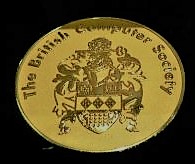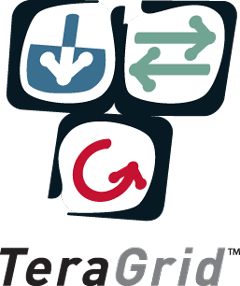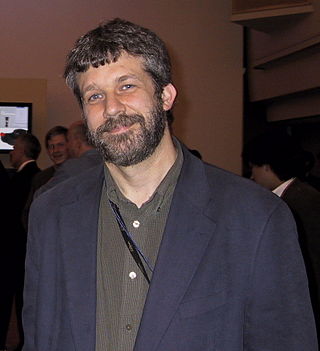Related Research Articles
Grid computing is the use of widely distributed computer resources to reach a common goal. A computing grid can be thought of as a distributed system with non-interactive workloads that involve many files. Grid computing is distinguished from conventional high-performance computing systems such as cluster computing in that grid computers have each node set to perform a different task/application. Grid computers also tend to be more heterogeneous and geographically dispersed than cluster computers. Although a single grid can be dedicated to a particular application, commonly a grid is used for a variety of purposes. Grids are often constructed with general-purpose grid middleware software libraries. Grid sizes can be quite large.

Jack Joseph Dongarra is an American computer scientist and mathematician. He is the American University Distinguished Professor of Computer Science in the Electrical Engineering and Computer Science Department at the University of Tennessee. He holds the position of a Distinguished Research Staff member in the Computer Science and Mathematics Division at Oak Ridge National Laboratory, Turing Fellowship in the School of Mathematics at the University of Manchester, and is an adjunct professor and teacher in the Computer Science Department at Rice University. He served as a faculty fellow at the Texas A&M University Institute for Advanced Study (2014–2018). Dongarra is the founding director of the Innovative Computing Laboratory at the University of Tennessee. He was the recipient of the Turing Award in 2021.

The Lovelace Medal was established by the British Computer Society in 1998, and is presented to individuals who have made outstanding contributions to the understanding or advancement of computing. It is the top award in computing in the UK. Awardees deliver the Lovelace Lecture.
The Biomedical Informatics Research Network, commonly referred among analysts as “BIRN” is a national proposed project to assist biomedical researchers in their bioscience investigations through data sharing and online collaborations. BIRN provides data-sharing infrastructure, advisory services from a single source and software tools and techniques. This national initiative is funded by NIH Grants, the National Center for Research Resources and the National Institute of General Medical Sciences (NIGMS), a component of the United States National Institutes of Health (NIH).

David A. Bader is a Distinguished Professor and Director of the Institute for Data Science at the New Jersey Institute of Technology. Previously, he served as the Chair of the Georgia Institute of Technology School of Computational Science & Engineering, where he was also a founding professor, and the executive director of High-Performance Computing at the Georgia Tech College of Computing. In 2007, he was named the first director of the Sony Toshiba IBM Center of Competence for the Cell Processor at Georgia Tech.
Carl Kesselman is an American computer scientist specializing in grid computing technologies. This term was developed by him and professor Ian Foster in the book The Grid: Blueprint for a New Computing Infrastructure. He and Foster are winners of the British Computer Society's Lovelace Medal for their grid work. He is institute fellow at the University of Southern California's Information Sciences Institute and a professor in the Epstein Department of Industrial and Systems Engineering, at the University of Southern California.

TeraGrid was an e-Science grid computing infrastructure combining resources at eleven partner sites. The project started in 2001 and operated from 2004 through 2011.

Charlie Catlett is a senior computer scientist at Argonne National Laboratory and a visiting senior fellow at the Mansueto Institute for Urban Innovation at the University of Chicago. From 2020 to 2022 he was a senior research scientist at the University of Illinois Discovery Partners Institute. He was previously a senior computer scientist at Argonne National Laboratory and a senior fellow in the Computation Institute, a joint institute of Argonne National Laboratory and The University of Chicago, and a senior fellow at the University of Chicago's Harris School of Public Policy.
Thomas Albert "Tom" DeFanti is an American computer graphics researcher and pioneer. His work has ranged from early computer animation, to scientific visualization, virtual reality, and grid computing. He is a distinguished professor of Computer Science at the University of Illinois at Chicago, and a research scientist at the California Institute for Telecommunications and Information Technology (Calit2).
Nimrod is a tool for the parametrization of serial programs to create and execute embarrassingly parallel programs over a computational grid. It is a co-allocating, scheduling and brokering service. Nimrod was one of the first tools to make use of heterogeneous resources in a grid for a single computation. It was also an early example of using a market economy to perform grid scheduling. This enables Nimrod to provide a guaranteed completion time despite using best-effort services.
Gul Agha is a professor of computer science at the University of Illinois at Urbana-Champaign, and director of the Open Systems Laboratory. He is known for his work on the actor model of concurrent computation, and was also Editor-in-Chief of ACM Computing Surveys from 1999 to 2007. Agha was born and completed his early schooling in Sindh, Pakistan. Agha completed his B.S. with honors at the California Institute of Technology in the year 1977. He received his Ph.D. in Computer and Communication Science from the University of Michigan in 1986 under the supervision of John Holland. However, much of his doctoral research was carried out in Carl Hewitt's Message-Passing Semantics Group at Massachusetts Institute of Technology (MIT). Agha's dissertation was published by the MIT Press as Actors: a model of concurrent computation in distributed systems, a book which, according to the ACM Guide to Computing Literature, has been cited over 3000 times.
Marc Snir is an Israeli-American computer scientist. He holds a Michael Faiman and Saburo Muroga Professorship in the Department of Computer Science at the University of Illinois at Urbana-Champaign. He currently pursues research in parallel computing. He was the principal investigator (PI) for the software of the petascale Blue Waters system and co-director of the Intel and Microsoft-funded Universal Parallel Computing Research Center (UPCRC).

Fabric computing or unified computing involves constructing a computing fabric consisting of interconnected nodes that look like a weave or a fabric when seen collectively from a distance.
The Sidney Fernbach Award established in 1992 by the IEEE Computer Society, in memory of Sidney Fernbach, one of the pioneers in the development and application of high performance computers for the solution of large computational problems as the Division Chief for the Computation Division at Lawrence Livermore Laboratory from the late 1950s through the 1970s. A certificate and $2,000 are awarded for outstanding contributions in the application of high performance computers using innovative approaches. The nomination deadline is 1 July each year.
The Ken Kennedy Award, established in 2009 by the Association for Computing Machinery and the IEEE Computer Society in memory of Ken Kennedy, is awarded annually and recognizes substantial contributions to programmability and productivity in computing and substantial community service or mentoring contributions. The award includes a $5,000 honorarium and the award recipient will be announced at the ACM - IEEE Supercomputing Conference.

James Weldon Demmel Jr. is an American mathematician and computer scientist, the Dr. Richard Carl Dehmel Distinguished Professor of Mathematics and Computer Science at the University of California, Berkeley.
Marsha J. Berger is an American computer scientist. Her areas of research include numerical analysis, computational fluid dynamics, and high-performance parallel computing. She is a Silver Professor (emeritus) of Computer Science and Mathematics in the Courant Institute of Mathematical Sciences of New York University. She is Group Leader of Modeling and Simulation in the Center for Computational Mathematics at the Flatiron Institute.

Albert Y. Zomaya is currently the Chair Professor of High Performance Computing & Networking and Australian Research Council Professorial Fellow in the School of Information Technologies, The University of Sydney. He is also the Director of the Centre for Distributed and High Performance Computing. He is currently the Editor in Chief of IEEE Transactions on Sustainable Computing and Springer's Scalable Computing and Communications. He was past Editor in Chief of the IEEE Transactions on Computers.

Valerie Elaine Taylor is an American computer scientist who is the director of the Mathematics and Computer Science Division of Argonne National Laboratory in Illinois. Her research includes topics such as performance analysis, power analysis, and resiliency. She is known for her work on "Prophesy," described as "a database used to collect and analyze data to predict the performance on different applications on parallel systems."
Katarzyna Keahey is a Senior Computer Scientist at Argonne National Laboratory and the Consortium for Advanced Science and Engineering (CASE) of the University of Chicago. She is a Principal Investigator (PI) of the Chameleon project, which provides an innovative experimentation platform for computer science systems experiments. She created Nimbus, one of the first open source implementations of infrastructure-as-a-Service (IaaS), and co-founded the SoftwareX journal, publishing software as a scientific instrument.
References
- ↑ Foster, I. (2001). "The Anatomy of the Grid: Enabling Scalable Virtual Organizations". International Journal of High Performance Computing Applications. 15 (3): 200–222. arXiv: cs/0103025 . Bibcode:2001cs........3025F. doi:10.1177/109434200101500302. S2CID 28969310.
- ↑ Foster, I.; Kesselman, C. (1997). "Globus: A Metacomputing Infrastructure Toolkit". International Journal of High Performance Computing Applications. 11 (2): 115. CiteSeerX 10.1.1.48.6898 . doi:10.1177/109434209701100205. S2CID 438757.
- ↑ Qiu, J.; Foster, I.; Goble, C. (2014). "Emerging Computational Methods for the Life Sciences Workshop 2012". Concurrency and Computation: Practice and Experience. 26 (6): 1231. doi:10.1002/cpe.3101. S2CID 26141575.
- ↑ "Ian Foster appointed to third term as director of Computation Institute". University of Chicago. 24 August 2012. Retrieved 10 January 2020.
- ↑ "Researchers Win Gordon Bell Prize for 2001". Argonne National Laboratory. Retrieved 10 January 2020.
- ↑ "Ian Foster to receive 2002 Lovelace Medal from British Computer Society". University of Chicago. 21 October 2002. Retrieved 10 January 2020.
- ↑ "Hon doc – Professor Ian Foster". University of Canterbury . Retrieved 18 May 2021.
- ↑ "Ian T. Foster". IEEE Computer Society. 8 June 2018. Retrieved 10 January 2020.
- ↑ "Ian Foster Named Recipient of 2019 IEEE Computer Society Charles Babbage Award". IEEE Computer Society. 7 March 2019. Retrieved 10 January 2020.
- ↑ "Dr. Ian Foster and Dr. Carl Kesselman to Receive 2020 IEEE Computer Society Harry H. Goode Memorial Award". IEEE Computer Society. 3 March 2020. Retrieved 16 March 2021.
- 1 2 "IEEE Internet Award" (PDF). Institute of Electrical and Electronics Engineers . Retrieved 29 December 2022.
- ↑ "Ian Foster Recognized with ACM-IEEE CS Ken Kennedy Award".
- ↑ Steve Koppes (6 November 2003). "Nine on faculty elected 2003 AAAS fellows". University of Chicago Chronicle. Vol. 78, no. 4.
- ↑ "Argonne's Ian Foster named Fellow of the Association for Computing Machinery". Argonne National Laboratory. 1 December 2009. Retrieved 10 January 2020.
- ↑ "Achievement Award". HPDC 2012 web site. Retrieved 10 January 2020.
- ↑ Ian Foster (22 June 2012). "20 years of grid computing" (PDF). HPDC 2012 award talk. Retrieved 10 January 2020.
- ↑ "The Euro-Par Achievement Award" . Retrieved 10 January 2020.
- ↑ "Strong hints of the Higgs – live from CERN". Gridcast blog. 4 July 2012. Retrieved 10 January 2020.
- ↑ "Form D: Notice of Sale of Securities" (PDF). US Securities and Exchange Commission. 25 August 2005. Retrieved 10 January 2020.